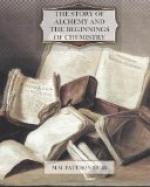The atomic theory of the Greek thinkers was constructed by reasoning on natural phenomena. Lucretius constantly appeals to observed facts for confirmation of his theoretical teachings, or refutation of opinions he thought erroneous. Besides giving a general mental presentation of the material universe, the theory was applied to many specific transmutations; but minute descriptions of what are now called chemical changes could not be given in terms of the theory, because no searching examination of so much as one such change had been made, nor, I think, one may say, could be made under the conditions of Greek life. More than two thousand years passed before investigators began to make accurate measurements of the quantities of the substances which take part in those changes wherein certain things seem to be destroyed and other totally different things to be produced; until accurate knowledge had been obtained of the quantities of the definite substances which interact in the transformations of matter, the atomic theory could not do more than draw the outlines of a picture of material changes.
A scientific theory has been described as “the likening of our imaginings to what we actually observe.” So long as we observe only in the rough, only in a broad and general way, our imaginings must also be rough, broad, and general. It was the great glory of the Greek thinkers about natural events that their observations were accurate, on the whole, and as far as they went, and the theory they formed was based on no trivial or accidental features of the facts, but on what has proved to be the very essence of the phenomena they sought to bring into one point of view; for all the advances made in our own times in clear knowledge of the transformations of matter have been made by using, as a guide to experimental inquiries, the conception that the differences between the qualities of substances are connected with differences in the weights and movements of minute particles; and this was the central idea of the atomic theory of the Greek philosophers.




